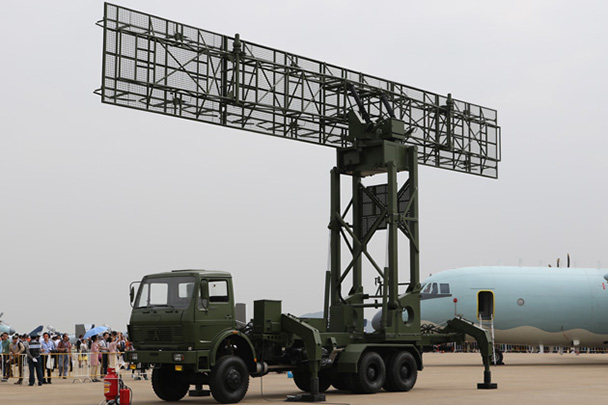From left to right: YLC-2A, JY-26 and JH-18.
Note that CETC labelled the centre radar JY-26, even though it is completely different to the design shown in 2014.
Although exhibited in public, data on the performance characteristics to back up the cutting-edge claims is less forthcoming. Anti-stealth radars typically operate at frequencies below 1GHz, because low-observable aircraft are designed to minimise their cross section to radars operating within radio spectrum covered by the IEEE S, C, and X bands (broadly 2-12 GHz).
At lower frequencies, radar reflections increase as the wavelength becomes closer to the physical size of parts of the aircraft and also resonances may be induced in parts of the airframe by the radar pulse, increasing the aircraft's susceptibility to detection and tracking.
The JY-26 Skywatcher-U, an active electronically scanned array (AESA) radar operating in the VHF/UHF frequencies, debuted at the Zhuhai Air Show in 2014. Developed by the 14th Institute (Nanjing Research Institute of Electronics Technology, or NRIET), the trailer-mounted radar allegedly has a 500km detection range and can track 500 targets simultaneously.
Whilst in development in Shandong, operators claimed that it detected USAF F-22 fighters flying over South Korea. CETC states, ‘The radar is designed to meet air defence needs for decades to come,’ and that it is robust against jamming and electronic counter-countermeasures.
Oddly, in Zhuhai this year CETC showed a completely different JY-26 radar design without the distinctive ‘bubble wrap’ transmit receive modules seen in the 2014 example. It is unclear whether this change relates to mislabelling, disinformation or redesign, but the manufacturer stated the JY-26 was ‘developed to be a mainstay radar in a national air defence system for long-range surveillance and tactical missile defence’.
The YLC-2A is a solid-state, L-band, 3-D long-range surveillance radar mounted on an 8x8 truck. CETC stated, ‘It can be used as a national-level backbone intelligence radar providing comprehensive information…’ It can also serve as a target indication radar for air defence weapons.
The truck-mounted JH-18 is a multifunction 3-D low-altitude surveillance radar dedicated to detecting air and sea surface targets. It is a phased-array system that fills gaps left by more powerful surveillance radars.
From left to right are the JY-27A, YLC-8B, and SLC-7. Source: Via dy.163.com
JY-27A 3-D long-range surveillance/guidance radar. Operating in the VHF band, it adopts 2-D electronic scanning in azimuth and elevation. It is active phased array system, and it is stated to be resistant to jamming and with ‘high measurement accuracy’. The trailer-mounted radar is in service and has been spotted in Shigatse, Tibet, for example.
There are unverified claims that the radar can pick up hostile stealth fighters at ranges of up to 500km. If these reports are accurate, such Chinese radars could swiftly nullify the advantages of stealth aircraft. The JY-27A is also designed to address the ballistic missile threat.
The Nanjing Research Institute of Electronic Technology (NRIET) is at the forefront of CETC's programme and produced two of the units on display at the Zhuhai air show, the YLC-8B and SLC-7.
While the YLC-8B, a 3-D surveillance radar that operates in the IEEE UHF band (300 Mhz-1 GHz), had already been exhibited at Zhuhai in 2014, the SLC-7 made its debut at the show this year.
The long-range, early-warning YLC-8B is a UHF-band 3-D radar that appeared in Zhuhai two years ago. It utilises full coherent digital-pulse compression and moving target detection technology.
The SLC-7 operates in the IEEE L-band (1-2 GHz). According to NRIET, it with digital scanning in azimuth and elevation, as well as mechanical scanning in azimuth.
This was the first time this radar had been shown to the public.

The JY-50 is a 2-D passive radar for air surveillance and early warning in critical areas.
Yet another radar system was the JY-50, this being a 2-D passive system. It was ‘mainly for air surveillance and early warning in silence of vital and critical areas’. This truck-mounted digital radar is claimed to have an ‘excellent stealth target detection capability’.
China Electronics Corporation (CEC) is another radar manufacturer. The REL-4 is a long-range 3-D radar that operates in the L-band. This mechanically scanned system is used for target guidance and air surveillance. CEC said, ‘It can integrate and manage information from several radars to complete data fusion and to form an area network.’
CETC reported in September that the country’s first single-photon quantum radar system could detect stealthy aircraft at a 100km range using quantum entanglement.
Such quantum-based radars mounted on vehicles or aircraft could detect stealthy aircraft at long ranges .
DARPA and Lockheed Martin are investing in similar radar technologies.
CETC is working with scientists at the University of Science and Technology of China in Hefei, Anhui province, which has achieved many breakthroughs in quantum physics, including developing the world’s first quantum satellite.
With regional countries such as India, Japan and South Korea joining the US in inducting stealth fighters in coming years, China’s radar capabilities, whether hyped up or not, will give them pause for thought.
The exhibition of these radars at the Zhuhai Air Show also shows what technology is also available to export clients.


Post a Comment Blogger Facebook Disqus